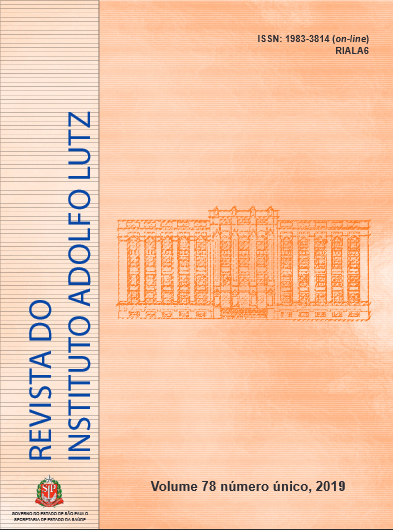Abstract
This study aimed at evaluating the antifungal activity of glucoprotamine solution (GLU) and the
essential oil from Cymbopogon citratus (EO). Candida tropicalis, Claviceps lusitaniae, Meyerozyma
(Pichia) guilliermondii and Candida parapsilosis were isolated from the samples, which were collected
from the surfaces of a public hospital located in Pelotas, RS. The antifungal activity of GLU was
detected at the concentrations from 0.25% to 0.0005%, while the EO, by Clevenger, was used at
concentrations from 17.500 μg mL to 0.034 μg/mL. Chemical analysis was determined by GC/MS.
The anti-Candida activity was performed by using Broth Microdilution technique to determine
the Minimal Fungicidal Concentration (MFC) and the Minimal Inhibitory Concentration (MIC).
The inhibition by GLU occurred at all of the tested concentrations, whereas the EO showed MIC
ranging from 2.846 to 5.450 μ/mL and the CFM from 2.853 to 5.330 μg/mL. Alfa–citral (37.10%),
beta–citral (32.77%) and beta-mirceno (18.75%) were the majority compounds in the EO. The data
obtained in the present study highlight the effectiveness of the solution based on GLU and EO for
eliminating the environmental isolates of Candida spp.
References
WMS, Brondi L. Perfil da Infecção Hospitalar em
um Hospital Universitário. Rev enferm UERJ.
2009;17(1):96-101. Disponível em: http://files.bvs.br/
upload/S/0104-3552/2009/v17n1/a017.pdf
2. Collins AS. Preventing health care–associated
infections. In: Hughes RG, editor. Patient safety and
quality: An evidence-based handbook for nurses.
Rockville (MD): Agency for Healthcare Research and
Quality (US); 2008 Apr. Chapter 41.
3. Agência Nacional de Vigilância Sanitária - ANVISA.
Segurança do paciente em serviços de saúde: limpeza
e desinfecção de superfícies; 2012.120p.
4. Zeitler B, Rapp I. Surface-dried viruses can
resist glucoprotamin-ased disinfection. Appl
Environ Microbiol. 2014;80(23):7169-75.
https://doi.org/10.1128/AEM.02462-14
5. Genz TB, Callai T, Schlesener VRF, Oliveira CF,
Renner JDP. Eficácia antibacteriana de a1gentes de
limpeza na desinfecção de superfícies de consultórios
odontológicos. RFO UPF (Online). 2017;22(2):162-6.
https://doi.org/10.5335/rfo.v22i2.6781
6. Tyski S, Grzybowsa W, Grzeszczuk S, Leszczynski
P, Staniszewska M, Röhm-Rodowald E et al.
Antimicrobial activity of Glucoprotamin-containning
disinfectants. Pol J Microbiol. 2009; 58 (4): 347-53.
7. Sá Silva F, Ferreira TM, Teodoro GR, Costa ACBP,
Maria A, Beltrame Junior M et al. Atividade
antifúngica do óleo essencial de Cymbopogon
citratus frente a cepas de Candida albicans e Candida
tropicalis isoladas de infecções nosocomiais. Rev Inst
Adolfo Lutz. 2009;68:434-41. Disponível em: http://
www.ial.sp.gov.br/resources/insituto-adolfo-lutz/
publicacoes/rial/2000/rial68_3_completa/1241.pdf
8. Brasil. Farmacopeia Brasileira / Agência Nacional
de Vigilância Sanitária. 5.ed. Brasília (DF): Anvisa;
2010. 546 p.
9. Irinyi L, Lackner M, De Hoog S, Meyer W.DNA
barcoding of fungica using infections in humans
and animals. Fungal Biol. 2016;125(2):125-36.
https://doi.org/10.1016/j.funbio.2015.04.007
10. CLSI. Clinical and Laboratory Standards Institute.
Reference method for broth dilution antifungal
susceptibility testing of yeasts. 4th Informational
Supplement. CLSI document M27-S4. Wayne:
Clinical and Laboratory Standards Institute; 2012.
11. Widmer AE, Frei R. Antimicrobial activity of
glucoprotamina: a clinical study of a new disinfectant
for instruments. Infect Control Hosp Epidemiol.
2003;24(10):762-4. https://doi.org/10.1086/502128
12. Cechinel Filho V, Yunes RA. Estratégias para obtenção
de compostos farmacologicamente ativos a partir
de plantas medicinais: conceitos sobre modificação
estrutural para otimização da atividade. Quím Nova.
1998;21(1):99-105. http://dx.doi.org/10.1590/S0100-
40421998000100015
13. Singh BR, Singh V, Singh RK, Ebibeni N. Antimicrobial
activity of lemongrass (Cymbopogon citratus) oil
against microbes of environmental, clinical and food
origin. Int Res J Pharm Pharmacol. 2011;1(9):228-36.
Disponível em: https://www.interesjournals.org/
articles/antimicrobial-activity-of-lemongrasscymbopogon-
citratus-oil-against-microbes-ofenvironmental-
clinical-and-food-origin.pdf
14. Mathew TK, Aswathy PG, Surya NK, Honey M,
Kuriakose J. Study on disinfectant potential of lemon
grass oil against common pathogens. Int J Adv
Res. 2016;4(7): 675-9. http://dx.doi.org/10.21474/
IJAR01/926
15. Tyagi AK, Malik SA. Liquid and vapour-phase
antifungal activities of selected essential oils against
Candida albicans: microscopic observations and
chemical characterization of Cymbopogon citratus.
BMC Complement Altern Med. 2010;10:65.
https://doi.org/10.1186/1472-6882-10-65
16. Khan MSA, Ahmad I. In vitro antifungal, antielastase
and anti-keratinase activity of essential oils of
Cinnamomum-, Syzygium- and Cymbopogon species
against Aspergillus fumigatus and Trichophyton
rubrum. Phytomedicine. 2011; 19 (1):48–55. https://
doi.org/10.1016/j.phymed.2011.07.005
17. Miron D, Battisti F, Silva FK, Lana AD, Pippi B,
Casanova B et al. Antifungal activity and mechanism
of action of monoterpenes against dermatophytes
and yeasts. Rev Bras Farmacogn. 2014;24(6):660-7.
https://doi.org/10.1016/j.bjp.2014.10.014
18. Agência Nacional de Vigilância Sanitária - ANVISA.
Boletim Informativo. Segurança do Paciente e
Qualidade em Serviços de Saúde no14; 2015.

This work is licensed under a Creative Commons Attribution 4.0 International License.
Copyright (c) 2019 Instituto Adolfo Lutz Journal
